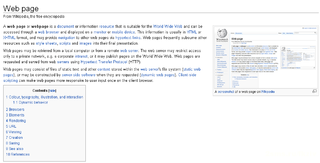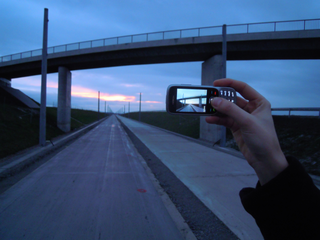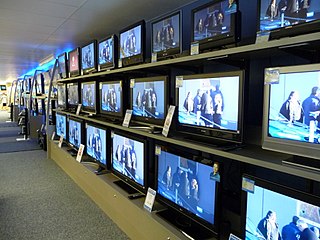Electronica encompasses a broad group of electronic-based styles such as techno, house, ambient, jungle and other electronic music styles intended not just for dancing.

Broadcasting is the distribution of audio or video content to a dispersed audience via any electronic mass communications medium, but typically one using the electromagnetic spectrum, in a one-to-many model. Broadcasting began with AM radio, which came into popular use around 1920 with the spread of vacuum tube radio transmitters and receivers. Before this, all forms of electronic communication were one-to-one, with the message intended for a single recipient. The term broadcasting evolved from its use as the agricultural method of sowing seeds in a field by casting them broadly about. It was later adopted for describing the widespread distribution of information by printed materials or by telegraph. Examples applying it to "one-to-many" radio transmissions of an individual station to multiple listeners appeared as early as 1898.
Internet culture, or cyberculture, is the culture that has emerged, or is emerging, from the use of computer networks for communication, entertainment, and business. Internet culture is also the study of various social phenomena associated with the Internet and other new forms of the network communication, such as online communities, online multi-player gaming, wearable computing, social gaming, social media, mobile apps, augmented reality, and texting, and includes issues related to identity, privacy, and network formation.
Within a capitalist economic system, Commodification is the transformation of goods, services, ideas and people into commodities or objects of trade. A commodity at its most basic, according to Arjun Appadurai, is "anything intended for exchange," or any object of economic value.
An electronic signature, or e-signature, refers to data in electronic form, which is logically associated with other data in electronic form and which is used by the signatory to sign. This type of signature provides the same legal standing as a handwritten signature as long as it adheres to the requirements of the specific regulation it was created under.

A sound module is an electronic musical instrument without a human-playable interface such as a piano-style musical keyboard. Sound modules have to be operated using an externally connected device, which is often a MIDI controller, of which the most common type is the musical keyboard. Controllers are devices that provide the human-playable interface and which may or may not produce sounds of its own. Another common way of controlling a sound module is through a sequencer, which is computer hardware or software designed to record and play back control information for sound-generating hardware. Connections between sound modules, controllers, and sequencers are generally made with MIDI, which is a standardized protocol designed for this purpose, which includes special ports (jacks) and cables.
Enterprise content management (ECM) extends the concept of content management by adding a time line for each content item and possibly enforcing processes for the creation, approval and distribution of them. Systems that implement ECM generally provide a secure repository for managed items, be they analog or digital, that indexes them. They also include one or more methods for importing content to bring new items under management and several presentation methods to make items available for use.

Electronic media are media that use electronics or electromechanical audience to access the content. This is in contrast to static media, which today are most often created electronically, but do not require electronics to be accessed by the end user in the printed form. The primary electronic media sources familiar to the general public are video recordings, audio recordings, multimedia presentations, slide presentations, CD-ROM and online content. Most new media are in the form of digital media. However, electronic media may be in either analogue electronics data or digital electronic data format.
In anthropology, deterritorialization refers to the weakening of ties between a location and the cultural entities such as people, objects, languages, or traditions associated with that location.

Digital forensics is a branch of forensic science encompassing the recovery and investigation of material found in digital devices, often in relation to computer crime. The term digital forensics was originally used as a synonym for computer forensics but has expanded to cover investigation of all devices capable of storing digital data. With roots in the personal computing revolution of the late 1970s and early 1980s, the discipline evolved in a haphazard manner during the 1990s, and it was not until the early 21st century that national policies emerged.
A webisode is an episode of a series that is distributed as web television. It is available as either for download or in streaming, as opposed to first airing on broadcast or cable television. The format can be used as a preview, a promotion, as part of a collection of shorts, or a commercial. A webisode may or may not have been broadcast on TV. What defines it is its online distribution on the web, or through video-sharing web sites such as Vimeo or YouTube. While there is no set standard for length, most webisodes are relatively short, ranging from 3–15 minutes in length. It is a single web episode, but collectively is part of a web series, a form called web television that characteristically features a dramatic, serial storyline, where the primary method of viewership is streaming online over the Internet. The term webisode was first introduced in the Merriam-Webster's Collegiate Dictionary in 2009.
Digital marketing is the marketing of products or services using digital technologies, mainly on the Internet, but also including mobile phones, display advertising, and any other digital medium.

Data is a set of values of subjects with respect to qualitative or quantitative variables.

Digital hoarding is excessive acquisition and reluctance to delete electronic material no longer valuable to the user. The behavior includes the mass storage of digital artifacts and the retention of unnecessary or irrelevant electronic data. The term is increasingly common in pop culture, used to describe the habitual characteristics of compulsive hoarding, but in cyberspace. As with physical space in which excess items are described as "clutter" or "junk", excess digital media is often referred to as "digital clutter".
Ethnoscape is one of five elementary frameworks used by Arjun Appadurai, in purpose of exploring fundamental discrepancies of global cultural flows. The suffix -scape indicates that these terms are perspectival constructs inflected by the historical, linguistic, and political situatedness of different kinds of actors: nation-states, multinationals, diasporic communities, and subnational groupings and movements, whether religious, political, or economic, etc..
Technoscape is a term coined by Arjun Appadurai in order to describe one of the five dimensions of global cultural flows. The five dimensions consist of ethnoscapes, mediascapes, technoscapes, financescapes, and ideoscapes. The suffix -scape denotes that these terms are perspectival constructs inflected by the historical, linguistic, and political situatedness of different kinds of actors: "nation-states, multinationals, diasporic communities, as well as subnational groupings and movements". This can either be religious, political, or economic. In a more specific scope, Technoscape is the movement of technology and the ability to move such technology at rapid speeds. This is due to the physical boundaries technology is able to maneuver around.
Financescape is one the five aspects of global cultural flows that renowned globalization theorist Arjun Appadurai proposed in his article Disjuncture and Difference in the Global Cultural Economy that he claims can be used to distinguish the various disjunctures or disconnections between economy, culture and politics, within the overall global economy. Appadurai poses that when considering the financescape framework, we must consider how global capital today moves in an increasingly fluid and non-isomorphic manner, thus contributing to an overall unpredictability of all the five aspects of global cultural flows as a whole. The four other aspects Appadurai mentions in his article are ethnoscapes, technoscapes, mediascapes and ideoscapes. Appadurai further states that despite disjunctures having always existed between the flows of people, machinery, money, ideas and images, the world is at a crossroads where this is happening to a larger extent; pointing to the importance of studying the "-scapes". These disjunctures also contribute to the central idea of deterritorialization which Appadurai describes as the main force affecting globalization in the sense that people from different countries and socioeconomic backgrounds are mixing with one another; namely the lower class of some countries integrating in to wealthier societies via the work force. Subsequently, these people reproduce their ethnic culture, but in a deterritorialized context.











